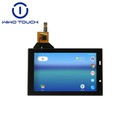Capacitive touch screen is an intelligent input device which can be used to achieve various operations by touch. In modern society, capacitive touch screens have been widely used in various electronic devices, such as smart phones, tablet PCs, laptops, etc. At the same time, capacitive touch screen also has an important application prospect in detection and control devices.
Data acquisition and monitoring: Capacitive touch screen can be used for data acquisition and real-time monitoring of various parameters in the system, such as temperature, pressure, humidity and so on. Through the touch screen interface, users can conveniently view and record these parameters and can alarm or adjust them as needed.
Device control and adjustment: Capacitive touch screen can be used as the main interface for device control, allowing users to control and adjust the working status of the device through touch operation. For example, for a liquid flow control device, the user can adjust the flow rate, open and close valves, etc. through the touch screen interface.
Troubleshooting and Alarm: The device can integrate troubleshooting and alarm functions, so that when an abnormality occurs in the detection and control device, the detection and control device can provide timely alarms and corresponding fault information. Users can quickly locate the problem and take appropriate maintenance measures through the touch screen to avoid downtime and losses.
Remote access and management: combined with Internet technology, capacitive touch screen can achieve remote access and management of detection and control devices. Users can remotely access the touch screen interface through a network connection to monitor and control the operation of the device, remote parameter adjustment and troubleshooting.
Capacitive touch screen in the detection and control device has the following benefits:
Intuitive and easy to use: capacitive touch screen provides an intuitive graphical interface, the user can complete a variety of settings and adjustments through a simple touch operation. Compared with the traditional buttons, switches and controls, capacitive touch screen is easier to understand and use, reducing the user's learning difficulty.
Multifunctionality: Capacitive touch screen can be integrated with a variety of functions, such as parameter adjustment, status monitoring, fault diagnosis, etc., which is especially important for detection and control devices. Through the capacitive touch screen, users can complete the operation in one-stop, without additional equipment or controller.
Flexibility and customisability: Capacitive touch screen is flexible and customisable, and can be custom designed according to the needs of different devices. Users can customise the display interface, set the operation flow and programming logic to meet specific control needs.
Space saving and aesthetics: Capacitive touch panels can replace traditional physical buttons and switches, thus saving space and improving the overall aesthetics of the device. Especially for complex detection and control devices, the application of capacitive touch screen can make the control interface more concise, intuitive, and enhance the user experience.
The high sensitivity of the touch screen allows the operator to respond quickly and accurately to the instructions, thereby improving production efficiency and product quality. Secondly, capacitive touch screen is dustproof, waterproof and wear-resistant, which enables it to work stably in harsh environments and ensure the performance and accuracy of the equipment. In addition, capacitive touch screen has a long service life and low maintenance cost, which can reduce long-term operating costs.





